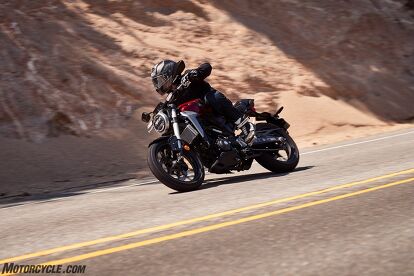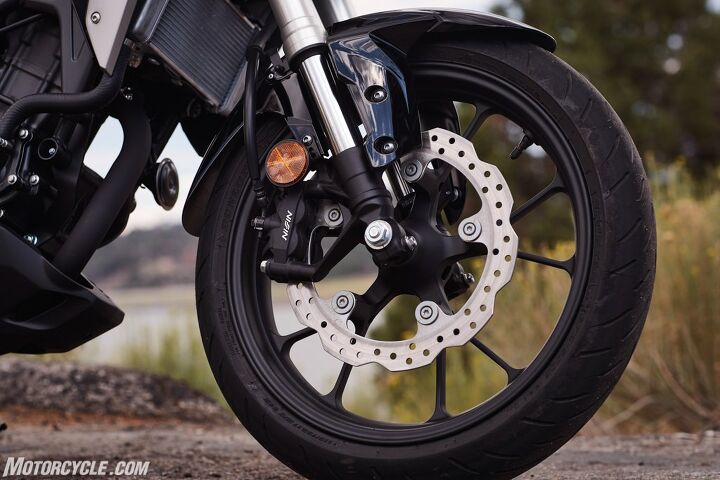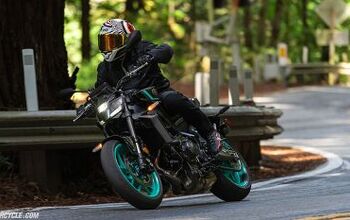2019 Honda CB300R Review - First Ride

Honda's little funster is new and improved for 2019
Honda’s all-in when it comes to the small-displacement category, perhaps more so than any other manufacturer out there. With the popularity of the Grom, CBR250R, CBR300R, CB300F, and Rebel lines – and recent introductions of the forthcoming Monkey and Super Cub – it’s no wonder Team Red is proud to introduce its latest addition – the 2018 CB300R.
2019 Honda CB300R
| Engine | 16.0/20 |
| Suspension/Handling | 13.0/15 |
| Transmission/Clutch | 7.5/10 |
| Brakes | 7.0/10 |
| Instruments/Controls | 4.0/5 |
| Ergonomics/Comfort | 7.0/10 |
| Appearance/Quality | 9.0/10 |
| Desirability | 9.0/10 |
| Value | 8.5/10 |
| Overall Score | 81/100 |
In case you doubted the importance manufacturers place on small-displacement motorcycles, consider this: Since 2011 Honda has sold over 50,000 250cc-500cc sport models. In case you missed the italics, this means Honda isn’t counting the Rebel, Grom, CB500X, or CRF250L/Rally into this figure. That’s big, y’all. And, depending on the displacement category, more than half of those buyers are buying their first motorcycle.
When it comes to motorcycles in this category, a few things stand out. Easily accessible performance is at the top of the list, but other factors like price, reliability and dealer support weigh on the minds of new or returning riders also. In the case of the CB300R, forking over $5,000 will get you a solid motorcycle with the performance, reliability, and support you expect from Honda. You’ll also get some change back, too. A little more if you don’t opt for ABS (not recommended), a little less if you do (recommended).
That new newNot just a CBR300R or CB300F with a funky gas tank and round headlight, the CB300R is an all-new model that just happens to share the 286cc Single in the other 300 models. The look is modeled after the CB1000R, with its sharp, almost futuristic lines and shapes. Honda calls it Neo Sports Cafe styling. In person, it just looks cool – which is refreshing to see since I’ve long wondered why small displacement motorcycles have always looked so…blah.
Go beyond the obvious styling differences, and the CB300R distinguishes itself from the CB300F in other ways. The R models get an inverted 41mm fork and an improved shock from Showa, and as you work your way down the fork leg, you’ll notice a radial-mount brake caliper, too. The brake disc itself is a single 296mm wave design with no center hub; the full floating rotor mounts directly to points on the wheel. As mentioned, ABS is an option, and Honda has even gone so far as to incorporate an IMU (yes, really) into the ABS to detect and mitigate rear wheel lift.
From there, the differences are a little harder to spot. Being an all-new model means there has to be something significantly different, and with the CB300R, that difference is the frame. The new trellis frame has reduced tube thickness and still uses the engine as a stressed member, but it’s mated to a separate pivot plate used to mount the swingarm (itself more rigid by 15%) and shock. On the engine front, there’s not much new to talk about here other than a redesigned intake tract offering a straighter shot into the throttle bodies.
One of Honda’s many goals was to make the CB300R as light as possible, and miraculously, Honda says the non-ABS version comes in at 313 lbs fully fueled, ready to ride – that’s a whopping 35 lbs less than the non-ABS CB300F. ABS versions weigh 317 lbs – 38 lbs less than a similarly equipped CB300F!
The little engine that couldHaving been spoiled by the Kawasaki Ninja 400 I’ve been riding lately, it was tough to gauge what to expect from the little Honda. Its 113cc displacement disadvantage wouldn’t do it any favors, but its featherweight status is a definite advantage. This becomes instantly clear the moment you sit on the CB. It’s so easy to pick up off the sidestand. If you aren’t ready, a good lunge might pop you over the other side. At 31.5 inches from the ground, the seat isn’t particularly close to the ground, but being light should help reduce the intimidation factor for those who struggle in the inseam department.
The other thing instantly noticeable is just how hard the saddle is. Comparing motorcycle seats to wood slabs is common in this line of work and for good reason – the metaphor is instantly relatable. The CB300R’s seat feels like a wooden slab covered in leather. It’s hard, but at least Honda positions this bike as a short- to medium-distance motorcycle, so no one’s getting fooled.
Once rolling, the 300R feels instantly familiar. It’s not the fastest motorcycle on the planet, but I was pleasantly surprised at how quickly it could get up to 65 mph. It’ll go faster, but don’t expect to get there in a hurry. Again, this is just another sign of Honda’s intended placement for the bike – an urban runabout also capable of a quick freeway blast to the local mountains. Through it all, though, the little single cylinder hardly transmits any offensive buzz to the bars. This despite having to run northward of 7,000 rpm on the highway.
Speaking of mountain runs, Honda’s 113-mile route for the assembled press to sample the CB300R took us from Honda’s Rider Education Center (a must-see if you’re even thinking about joining the moto ranks, dirt or street) up to Big Bear, which would be bringing us as high as 8,000 feet in elevation. Throughout the climb, the 286cc engine performed admirably – steadily chugging along even in sixth gear. If a slightly more rapid ascent was needed, a downshift was enough to scoot along without worrying about car traffic.
Get to the twisty bits along Highway 38, and the new chassis and suspension components come into their own. The 300R is so light, a few of the journos found ourselves having to recalibrate our turn-in points – that’s how quickly and easily we could toss the bike into corners. The beefier fork helped keep the front Dunlop planted and gave good feedback, and though some might view the meager power as a negative, none of the assembled journos, myself included, shared that thought. Modest horsepower means the rider has to master the fundamentals like proper shifting and maximizing momentum, which is exactly what a new or returning rider should be doing. In that regard, the CB300R nails it.
Just to make sure my feelings were justified, Honda also brought along a CB300F to ride back-to-back. You sit “in” the F model as opposed to “on” the R model, though the F’s seat is more plush. Pegs feel higher on the F model, and the bars are a bit narrower, too. Most noticeable of all is the weight difference. The F is far from heavy, but when hopping off one and onto another, the brain has to recalibrate for the extra mass.
As good as the CB300R is, there are some blemishes. First is the aforementioned plank of a seat. It’s hard and uncomfortable but tolerable for the medium distances it’s intended. While they work well enough, the brakes also deserve a wood analogy. I expected more bite and more power when squeezing the lever, which made it a little comical when remembering the ABS is equipped with an IMU to keep the rear end down. “Don’t think we’ll need that!” I scribbled in my notes. The CB300R has an elegant LCD dash that looks more modern compared to the CB300F. However, its black background with white lettering is harder to see in broad daylight than the F’s traditional white background with black lettering. Lastly, and this I’m certain is a result of our test units only having 100 miles on the odometer, shifting felt just a touch notchy. With more miles to break-in, I’m confident this won’t be an issue.
Coming in at $4,649 ($4,949 as-tested with ABS), the CB300R is a fun motorcycle, ideal for students or urban dwellers who don’t need to ride long distances at a time. That said, at the conclusion of our ride – which went beyond the 113-miles originally intended – we returned with two bars still showing on the gas gauge for the 2.7 gallon tank. It looks cool, goes well, and will likely turn some heads on campus with its styling. If you’re past college age, it’ll still look equally as cool in front of the coffee shop or in front of the office.
The competition is stacked in the small displacement field, but if the looks of the CB300R appeal to you, putting one in your garage will be a decision you won’t regret. Available in either Chromosphere Red or Matte Gray Metallic, they are arriving in dealers now.
2019 Honda CB300R
+ Highs
- Great styling
- Super lightweight
- Fun in the twisties!
– Sighs
- Seat sourced from a lumber yard
- Brakes, too
- Gauges are kinda hard to read in the sun
In Gear

Helmet: HJC RPHA 90 Starting at $413.99
- Jacket: Alpinestars Viper Jacket Tech-Air Compatible $469.95
- Pants: Aerostich Protekt Jeans Starting at $117.00
- Gloves: Alpinestars GP Air $129.95
Boots: Alpinestars SP-1 V1 Riding Shoe No longer available
2019 Honda CB300R Specifications | |
|---|---|
| Engine Type | 286cc liquid-cooled single-cylinder four-stroke |
| Valve Train | DOHC; four valves per cylinder |
| Bore x Stroke | 76.0mm x 63.0mm |
| Compression Ratio | 10.7:1 |
| Induction | Fuel injection w/ 38mm throttle body |
| Ignition | Full transistorized |
| Starter | Electric |
| Transmission | Manual w/ six speeds |
| Clutch | Multiplate wet |
| Final Drive | Chain |
| Front Suspension | 41mm telescopic fork; 5.1 in. travel |
| Rear Suspension | Pro-Link single shock; 4.2 in. travel |
| Front Brakes | Hydraulic w/ single 296mm disc; ABS optional |
| Rear Brakes | Hydraulic w/ single 220mm disc; ABS optional |
| Front Tires | 110/70-17 |
| Rear Tires | 150/60-17 |
| Rake | 24.7º |
| Trail | 3.7 in. |
| Length | 79.5 in. |
| Width | 31.7 in. |
| Height | 41.3 in. |
| Seat Height | 31.5 in. |
| Ground Clearance | 5.9 in. |
| Wheelbase | 53.3 in. |
| Fuel Capacity | 2.7 gal. |
| Color | Chromosphere Red; Matte Gray Metallic |
| Curb Weight | 313 lbs. / 317 lbs. with ABS (claimed) |

Troy's been riding motorcycles and writing about them since 2006, getting his start at Rider Magazine. From there, he moved to Sport Rider Magazine before finally landing at Motorcycle.com in 2011. A lifelong gearhead who didn't fully immerse himself in motorcycles until his teenage years, Troy's interests have always been in technology, performance, and going fast. Naturally, racing was the perfect avenue to combine all three. Troy has been racing nearly as long as he's been riding and has competed at the AMA national level. He's also won multiple club races throughout the country, culminating in a Utah Sport Bike Association championship in 2011. He has been invited as a guest instructor for the Yamaha Champions Riding School, and when he's not out riding, he's either wrenching on bikes or watching MotoGP.
More by Troy Siahaan


































































































































Comments
Join the conversation
Buh!
The 300cc is about 50-75cc too small!
It was so for the CBR300R with better fairings, and it will be so for this one for sure!
Save your money for one with more comfy seat, more upright riding position, and bigger engine!
300CC is ok for most parts, but just not good enough for interstate riding. Sure it can do 90MPH, but barely. Any bit of headwind, and you won't be able to surpass anyone doing 80MPH.
Not for me. Hyped up, under performing. And it seems like all of these bikes suffer from the same achilles heel! High revving, short geared, too much forward leaning bikes.
Uncomfortable, unpleasant!
Make the gearing 20-25% longer and it would be properly geared!
Then bump up the CC to the Honda equivalent of 400cc (probably 366cc for Honda) and the bike might just be good enough.
But as is?
A waste of production!
Please let Honda do like they did with the Rebel and stick the 500cc twin in this one!!